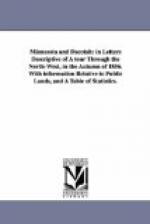with autumn-colored foliage, was enough to commend
the old fashioned system of stages to more general
use. Call it poetry or what you please, yet the
man who can contemplate with indifference the wonderful
profusion of nature, undeveloped by art—
inviting, yet never touched by the plough—
must lack some one of the senses. Indeed, this
picture, so characteristic of the new lands of the
West, seems to call into existence a new sense.
The view takes in a broad expanse which has never produced
a stock of grain; and which has been traversed for
ages past by a race whose greatest and most frequent
calamity was hunger. If we turn to its past there
is no object to call back our thoughts. All is
oblivion. There are no ruins to awaken curious
images of former life— no vestige of humanity—
nothing but the present generation of nature.
And yet there are traces of the past generations of
nature to be seen. The depressions of the soil
here and there to be observed, covered with a thick
meadow grass, are unmistakeable indications of lakes
which have now “vanished into thin air.”
That these gentle hollows were once filled with water
is the more certain from the appearance of the shores
of the present lakes, where the low water mark seems
to have grown lower and lower every year. But
if the past is blank, these scenes are suggestive
of happy reflections as to the future. The long
perspective is radiant with busy life and cheerful
husbandry. New forms spring into being.
Villages and towns spring up as if by magic, along
whose streets throngs of men are passing. And
thus, as “coming events cast their shadows before,”
does the mind wander from the real to the probable.
An hour and a half of this sort of revery, and we had
come to the Fort Ripley ferry, over which we were to
go for the mail. That ferry (and I have seen
others on the river like it) is a marvellous invention.
It is a flat-boat which is quickly propelled either
way across the river by means of the resistance which
it offers to the current. Its machinery is so
simple I will try to describe it. In the first
place a rope is stretched across the river from elevated
objects on either side. Each end of the boat is
made fast to this line by pullies, which can be taken
up or let out at the fastenings on the boat.
All that is required to start the boat is to bring
the bow, by means of the pully, to an acute angle
with the current. The after part of the boat
presents the principal resistance to the current by
sliding a thick board into the water from the upper
side. As the water strikes against this, the
boat is constantly attempting to describe a circle,
which it is of course prevented from doing by the current,
and so keeps on— for it must move somewhere—
in a direction where the obstruction is less.
It certainly belongs to the science of hydraulics,
for it is not such a boat as can be propelled by steam
or wind. I had occasion recently to cross the
Mississippi on a similar ferry, early in the morning,




